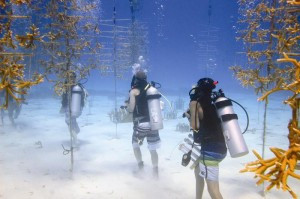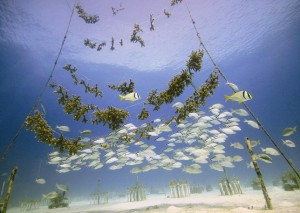Rebuilding the Reefs
Pet Age Staff //June 18, 2013//
The Coral Restoration Foundation’s goal is, “Education. Action. Results.” It may sound simple, but the complex work that they do takes time, money and lots of planning.
“It will take us years,” Ken Nedimyer, president of the Coral Restoration Foundation, said, of the group’s goal to restore the once abundant coral population.
In addition to growing and restoring threatened coral species, and enhance reproductive output to stimulate a natural recovery, the non-profit is working to enhance and promote awareness of coral reef health and survival, along with the environmental and social benefits of reef ecosystems.
They are also engage communities in nursery and restoration efforts by encouraging long-term involvement, as well as facilitating partnerships for the purpose of research, restoration and understanding of coastal resources.
To help do this, the group created a tiered sponsorship program where companies can literally sponsor a reef project.
One such group participating in this is the World Pet Association, who recently donated $25,000 to the group’s program.
The Coral Restoration Foundation, who is leading the development of offshore nursery and restoration methods to preserve unique genetic lineages of staghorn and elkhorn coral for research and restoration purposes, will plant the corals, take photos and provide the company with images of the work.
“We show them exactly where their money went,” Kevin Gaines said. “The money goes literally to the work that is being done, not to overhead.”
Gaines, who is now the vice president of sales and business development for Piscine Energetics, was most recently the operations manager for the Coral Restoration Foundation.
 During the two years he was there, he worked with Nedimyer and a small staff to build up the organization. That included expanding the nursery, getting volunteer divers involved in their education center, building awareness and most importantly educating everyone they could about the endangered corals.
During the two years he was there, he worked with Nedimyer and a small staff to build up the organization. That included expanding the nursery, getting volunteer divers involved in their education center, building awareness and most importantly educating everyone they could about the endangered corals.
Gaines knows a thing or two about what the area was like before stressors in the late 1970s and early 1980s caused the population to decline dramatically.
“My Dad used to take me to the Keys in the summer when I was a kid,” he said. “I would see an unbelievably healthy reed system. It just mesmerized me. Seeing the decline in the ‘80s, I was really depressed about it.”
From Then To Now
The Coral Restoration Foundation’s first restoration project was completed on the Wellwood grounding site on Molasses Reef in 2003, where six staghorn corals were placed on a Florida Keys National Marine Sanctuary reef module and can still be found on the site today.
Throughout the years, they have increased the restoration limits obtained through permits, and has outplanted thousands of coral at 12 different named reefs in the Upper Keys.
In addition, the Coral Restoration Foundation has re-attached thousands of broken fragments from natural causes at various sites throughout the Upper Keys.
To do this, they enlist volunteer divers who working with a hammer and chisel to set coral down on specific area of the appropriate reef.
“We clean out each post, but apoxy down and glue it to the reef,” Nedimyer explained. “Within a month or two the coral has grown over the apoxy. We build a community.”
A community, he says that is a vital element, both under the water and above, to the area where they are planting them.
“A lot of the economy in the Florida Keys depends on the reefs,” Nedimyer said. “Plus, a lot of costal communities are being inundated with large waves because there are no reefs to break them up.”
The work Nedimyer does, he says shows how the industry is giving back.
“This is our passion,” he said. “(Hobbyists) are giving back and leading the way in this area. People else where are dabbling in it, but we are leading the way.”



















